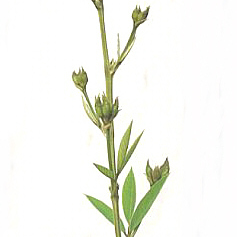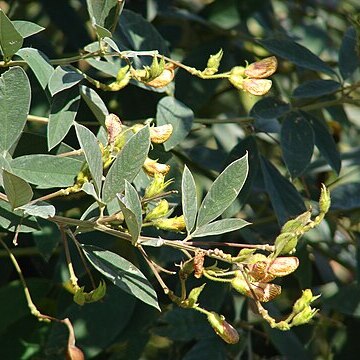Shrub or subshrub. Leaves trifoliolate, leaflets oblanceolate, puberulent; stip-ules lanceolate, caducous. Inflorescence an axillary or terminal panicle or ra-ceme, flowers 6-12 per rachis; bracts small, caducous. Flowers with calyx cam-panulate, 5-lobed, the upper lobe longer; corolla yellow with brown to maroon striation, the standard ovate, auriculate, the wing oblong, the keel falcate; sta-mens diadelphous, the vexillary stamen free, the anthers monomorphic; ovary sessile with 4-6 ovules, the style slender, glabrous, the stigma capitate. Fruit oblong, 2-valved with oblique constrictions between the seeds, yellowish green with brown mottling, puberulent; seeds 4-5, obovoid, hilum oblong, estrophio-late.
Shrubs or subshrubs. Leaves pinnately 3-foliolate, petiolate; leaflets covered with small yellow glands; stipules and stipels very small. Inflorescence a terminal panicle together with numerous subcapitate axillary racemes; pedicels long. Calyx 5-lobed; lobes subequal, the upper pair joined. Standard more or less round, auriculate. Vexillary stamen free; anthers uniform. Ovary elongate, 4–6-ovuled, velvety hairy; style thickened above, flattened below the small capitate stigma. Pod linear-oblong, inflated, with a long persistent acumen, 3–7-seeded, with the seeds separated by oblique grooves on the pod faces. Seeds rounded, compressed, with a linear hilum and small rim-aril.
Leaves pinnately, rarely subdigitately, 3-foliolate, petiolate; leaflets covered with small yellow glands beneath; stipules and stipels very small, or stipels absent.
Pod linear-oblong to oblong, inflated or compressed, with a long persistent acumen, 3–7-seeded, with the seeds separated by oblique grooves on the pod faces.
Inflorescence a terminal panicle together with numerous subcapitate axillary racemes, or all axillary or flowers fasciculate; pedicels long.
Seeds rounded or ovoid, compressed, with a hilum central on shorter side of seed, often linear with well developed or small rim aril.
Ovary elongate, 3–8-ovuled, velvety hairy; style filiform or thickened above, flattened below the small capitate stigma.
Calyx 5-lobed; lobes subequal, the upper pair joined to form a bifid lip.
Shrubs or subshrubs, climbers or prostrate herbs.
Corolla yellow, persistent or deciduous.
Vexillary stamen free; anthers uniform.
Standard ± round, auriculate.


